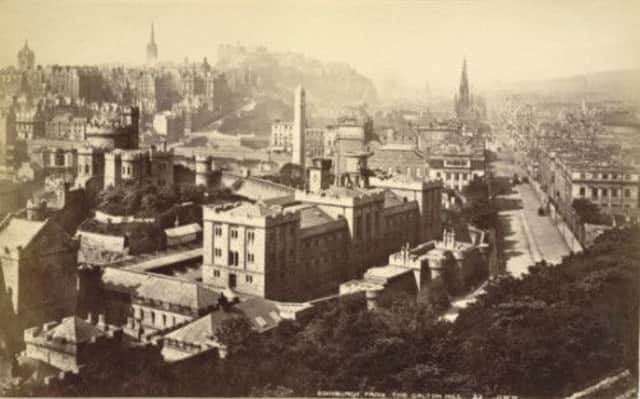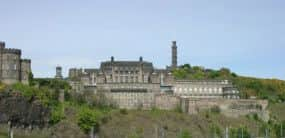Lost Edinburgh: Calton Jail


Calton Jail received its first prisoners in 1817. It was situated on the southern side of Regent Road under the shadow of Calton Hill. The prison was constructed to replace the ageing and dilapidated Old Tolbooth on the High Street as Edinburgh’s main correction facility. It is thought that architect Archibald Elliot, famous for his classical, Greek revival creations, designed the building in a distinctive castellated fashion so that it matched the style of other structures in the area such as Robert Adam’s debtors jail of 1791 known as “the Bridewell” and James Craig’s Old Observatory on top of Calton Hill. The decision to build the then largest jail in Scotland on such a prominent site led Lord Henry Cockburn to later complain: “It had been a piece of undoubted bad taste to give so glorious an eminence to a prison.” However, there were others who thought a little differently. On a visit to Auld Reekie in 1859, French novelist Jules Verne was impressed by Calton Jail, describing it as resembling a small scale version of a medieval town.
Public executions had ceased in Edinburgh in 1864 meaning from that point forward those who had committed crimes worthy of the ultimate penalty were sent to Calton Jail. Conditions for such inmates were horrendous. Those condemned to death faced a harsh existence fastened by chains to a long iron bar fixed to the wall while they waited for their execution day. Numerous prisoners were hanged at the jail over the years, often in full view of those desperate enough to peer over the high walls from the slopes of Calton Hill. In the jail’s latter days, executions took place inside the building. A solitary black flag would be flown to signal to the general public that it was all over. It is said that the bodies of ten souls executed at Calton Jail lie underneath the car park of modern-day St. Andrew’s House. One of the ten, Philip Murray, sentenced to death for murder by throwing a man out of a window on Jamaica Street, who he had discovered in bed with his wife, was the last to be hanged on October 30th 1923.
Prison life


Advertisement
Hide AdAdvertisement
Hide AdCalton Jail was a grim residence for those awaiting death but what about its regular inmates? One of the most detailed accounts of what life was like in the prison was written by a man named Willie Gallacher. Hailing from Glasgow, Gallacher was a vocal socialist who was charged with sedition during WW1. The authorities decided that he must serve his sentence at Calton Jail, far away from his hometown in order to prevent him from causing further dissension among the Glasgow population. Gallacher remarked: “It was by far the worst prison in Scotland; cold, silent and repellent. Its discipline was extremely harsh and the diet atrocious. The one hour’s exercise in the morning was the sole opportunity we had of seeing each other, when desperate attempts were made to exchange a whisper or two. For breakfast, we had thick porridge and sour milk. For dinner, soup and a piece of dry bread. And for supper, thick porridge and sour milk.” Fellow anti-war inmate Arthur Woodburn’s account was equally as damning when he described the jail as “the poorhouse of all prisons with the cold chill of a grim fortress.”
Neither Gallacher or Woodburn would have shed a tear then when the jail was demolished in 1930 - with the exception of its southern wall and Governor’s House which still exist today. The widely despised conditions of Calton Jail were considered vastly inadequate for the standards of the 20th century and after the jail’s closure in 1925, the inmates were relocated to the newly built Saughton Prison – which at that time was on the outskirts of the city. After becoming Labour’s Secretary of State for Scotland in 1947, former inmate Arthur Woodburn is said to have salvaged some of the stones from the jail to build a garden path for his home. A satisfying reminder for Mr Woodburn each time he strolled along his new path that he was now, all these years later, a successful and free man.
The imposing Art Deco Edinburgh landmark St. Andrew’s House, built in 1936 as the Scottish Office, stands on the site of Calton Jail today.
• David McLean is the founder of the Lost Edinburgh Facebook page